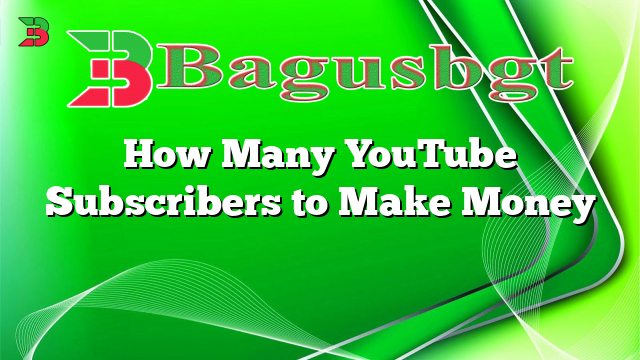Hello, dear readers! In this article, we will delve into the intriguing world of YouTube and explore the question that many aspiring content creators ask: how many YouTube subscribers does it take to start making money? We will uncover the various factors that influence this milestone, the pros and cons of monetizing your channel, and provide alternative ways to earn revenue on YouTube. Let’s get started!
1. Understanding YouTube’s Partner Program
Before we dive into the subscriber count, it’s important to understand YouTube’s Partner Program. To monetize your channel, you need to meet two main requirements: have at least 1,000 subscribers and accumulate 4,000 watch hours in the past 12 months. These thresholds ensure a certain level of engagement and consistency on your channel.
2. The Role of Subscribers in Monetization
While subscribers are important for building a loyal audience, it’s not solely about the subscriber count when it comes to making money on YouTube. Other factors, such as watch time, engagement, and ad revenue, also play a significant role. However, having a substantial subscriber base can increase your chances of achieving higher watch time and engagement, leading to more ad revenue.
3. The Magic Number: 1,000 Subscribers
Reaching 1,000 subscribers is a significant milestone as it allows you to join the YouTube Partner Program and start monetizing your channel. Once approved, you can enable ads on your videos and earn revenue based on the number of ad views and clicks. However, it’s important to note that the earnings may vary greatly depending on factors like niche, audience demographics, and ad rates.
4. Pros of Monetizing Your Channel
Monetizing your YouTube channel offers several advantages. Firstly, it provides a potential source of passive income. With a growing subscriber base and consistent content creation, you can earn money even when you’re not actively working on your channel. Secondly, it allows you to invest in better equipment, software, or resources to enhance the quality of your content. Lastly, monetization can serve as motivation to create and upload videos regularly.
5. Cons of Monetizing Your Channel
While monetization has its perks, it’s essential to consider the drawbacks as well. One of the main concerns is the potential impact on the viewer experience. Ads can sometimes be disruptive and may deter some viewers from watching your content. Additionally, strict adherence to YouTube’s monetization policies, such as avoiding copyrighted material, can limit creative freedom for some creators. Lastly, the income generated through ads alone may not be substantial, especially for channels with a smaller subscriber base.
6. Alternative Revenue Streams
If you’re looking to diversify your revenue streams, there are alternative options beyond ad revenue. Sponsored content, brand partnerships, merchandise sales, and crowdfunding are popular ways to generate income on YouTube. These methods often rely on building a strong personal brand and engaging with your audience authentically.
7. The Importance of Engagement
Regardless of the number of subscribers, engagement is crucial for YouTube success. Encouraging your viewers to like, comment, and share your videos helps boost your content’s visibility and reach. Building a community around your channel not only enhances your chances of making money but also creates a supportive environment for your content to thrive.
8. Tracking Your Progress
Tracking your subscriber count and watch time progress is essential for monitoring your channel’s growth. YouTube Analytics provides valuable insights into your audience demographics, traffic sources, and video performance. Regularly reviewing these metrics can help you make informed decisions to optimize your content strategy and increase your chances of monetization.
9. The Road to Success
Becoming a successful YouTuber is a journey that requires dedication, consistency, and a deep understanding of your target audience. While the number of subscribers is an important metric, don’t let it be the sole focus of your efforts. Instead, focus on creating valuable and engaging content that resonates with your viewers, and the subscribers and revenue will follow.
10. Frequently Asked Questions (FAQ)
| Question | Answer |
|---|---|
| 1. How long does it take to reach 1,000 subscribers? | The time it takes to reach 1,000 subscribers can vary greatly depending on various factors, including the quality of your content, consistency, and promotion efforts. It can range from a few months to a few years. |
| 2. Can I monetize my channel with less than 1,000 subscribers? | No, the YouTube Partner Program requires a minimum of 1,000 subscribers to start monetizing your channel. |
| 3. How much money can I make with a certain number of subscribers? | Earnings on YouTube can vary significantly based on factors like niche, audience demographics, ad rates, and engagement. It’s challenging to provide an exact figure as the income potential is highly individual. |
| 4. Are there any age restrictions for monetization? | Yes, to be eligible for monetization, you need to be at least 18 years old or have a legal guardian who can handle the monetization process on your behalf. |
Conclusion
In conclusion, reaching 1,000 subscribers is a significant milestone for monetizing your YouTube channel. However, it’s important to remember that the subscriber count is just one piece of the puzzle. Factors like watch time, engagement, and alternative revenue streams also contribute to your success. Focus on creating valuable content, engaging with your audience, and diversifying your income sources to maximize your chances of making money on YouTube. Good luck on your YouTube journey!
 Bagus Banget Kumpulan Informasi terbaru dari berbagai sumber yang terpercaya
Bagus Banget Kumpulan Informasi terbaru dari berbagai sumber yang terpercaya




